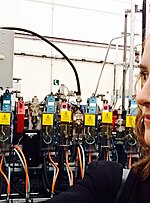Daresbury Laboratory

Daresbury Laboratory is a scientific research laboratory based at Sci-Tech Daresbury campus near Daresbury in Halton, Cheshire, England. The laboratory began operations in 1962 and was officially opened on 16 June 1967 as the Daresbury Nuclear Physics Laboratory by the then Prime Minister of United Kingdom, Harold Wilson. It was the second national laboratory established by the British National Institute for Research in Nuclear Science, following the Rutherford High Energy Laboratory (now Rutherford Appleton Laboratory). It is operated by the Science and Technology Facilities Council, part of UK Research and Innovation. As of 2018, it employs around 300 staff, with Paul Vernon appointed as director in November 2020, taking over from Professor Susan Smith who had been director from 2012.
Excerpt from the Wikipedia article Daresbury Laboratory (License: CC BY-SA 3.0, Authors, Images).Daresbury Laboratory
Keckwick Lane,
Geographical coordinates (GPS) Address Website Nearby Places Show on map
Geographical coordinates (GPS)
| Latitude | Longitude |
|---|---|
| N 53.343055555556 ° | E -2.6405555555556 ° |
Address
Sci-Tech Daresbury
Keckwick Lane
WA4 4AD
England, United Kingdom
Open on Google Maps








